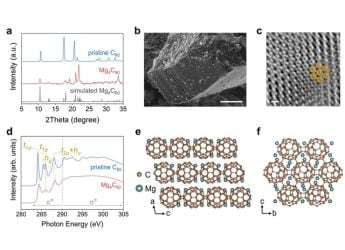- Home
- Science
- Science News
- The Future of Armour? New Chainmail Like Material Shows Promise
The Future of Armour? New Chainmail-Like Material Shows Promise
A breakthrough 2D polymer material has been developed with potential for body armour, offering strength and flexibility.

Photo Credit: Mark Seniw, Center for Regenerative Nanomedicine, Northwestern University
The illustration shows X-shaped monomers forming a strong 2D mechanically interlocked polymer
A new two-dimensional (2D) material that combines exceptional strength with flexibility has been created by a team led by Northwestern University. Described as resembling interlinked chainmail, this innovative material is lightweight and holds potential for applications such as advanced body armour and other high-performance uses. The breakthrough is credited to the development of a scalable polymerisation process that creates densely packed mechanical bonds, reportedly achieving a record-breaking 100 trillion mechanical bonds per square centimetre.
Structure and Development Process
According to the research published in Science, this material is the first of its kind—a 2D mechanically interlocked polymer. The team utilised X-shaped monomers, arranging them in a crystalline structure to facilitate the formation of mechanical bonds. William Dichtel, Robert L. Letsinger Professor of Chemistry at Northwestern University, noted in a statement, as reported by phys.org, that this novel polymer structure offers unique resistance to tearing.
He explained that the material can dissipate applied forces in various directions due to the freedom of movement within its mechanical bonds. Madison Bardot, a doctoral candidate and the study's first author, reportedly devised the concept for the material's formation. Describing the process as “high-risk, high-reward,” Dichtel attributed the success to rethinking traditional approaches to molecular crystal reactions. Layers of the resulting interlocked polymer sheets are said to provide both rigidity and flexibility, while their structure has been confirmed using advanced electron microscopy techniques by researchers at Cornell University.
Enhanced Properties and Applications
The material's inherent strength inspired researchers at Duke University, led by Matthew Becker, to incorporate it into Ultem, a robust polymer used in extreme conditions. A composite containing just 2.5 percent of the new material reportedly increased Ultem's toughness significantly. Dichtel suggested that the polymer could serve as a specialised material for ballistic fabrics and lightweight, protective gear.
The study was dedicated to the late Sir Fraser Stoddart, who pioneered the concept of mechanical bonds and was awarded the Nobel Prize in Chemistry in 2016 for his contributions to molecular machines.
Get your daily dose of tech news, reviews, and insights, in under 80 characters on Gadgets 360 Turbo. Connect with fellow tech lovers on our Forum. Follow us on X, Facebook, WhatsApp, Threads and Google News for instant updates. Catch all the action on our YouTube channel.
- Samsung Galaxy Unpacked 2025
- ChatGPT
- Redmi Note 14 Pro+
- iPhone 16
- Apple Vision Pro
- Oneplus 12
- OnePlus Nord CE 3 Lite 5G
- iPhone 13
- Xiaomi 14 Pro
- Oppo Find N3
- Tecno Spark Go (2023)
- Realme V30
- Best Phones Under 25000
- Samsung Galaxy S24 Series
- Cryptocurrency
- iQoo 12
- Samsung Galaxy S24 Ultra
- Giottus
- Samsung Galaxy Z Flip 5
- Apple 'Scary Fast'
- Housefull 5
- GoPro Hero 12 Black Review
- Invincible Season 2
- JioGlass
- HD Ready TV
- Laptop Under 50000
- Smartwatch Under 10000
- Latest Mobile Phones
- Compare Phones
- Honor Win RT
- Honor Win
- Xiaomi 17 Ultra Leica Edition
- Xiaomi 17 Ultra
- Huawei Nova 15
- Huawei Nova 15 Pro
- Huawei Nova 15 Ultra
- OnePlus 15R
- Asus ProArt P16
- MacBook Pro 14-inch (M5, 2025)
- OPPO Pad Air 5
- Huawei MatePad 11.5 (2026)
- Xiaomi Watch 5
- Huawei Watch 10th Anniversary Edition
- Acerpure Nitro Z Series 100-inch QLED TV
- Samsung 43 Inch LED Ultra HD (4K) Smart TV (UA43UE81AFULXL)
- Asus ROG Ally
- Nintendo Switch Lite
- Haier 1.6 Ton 5 Star Inverter Split AC (HSU19G-MZAID5BN-INV)
- Haier 1.6 Ton 5 Star Inverter Split AC (HSU19G-MZAIM5BN-INV)












